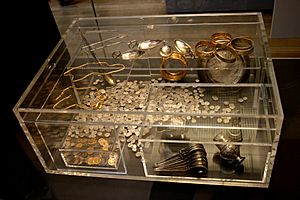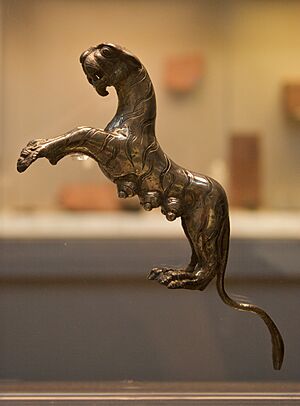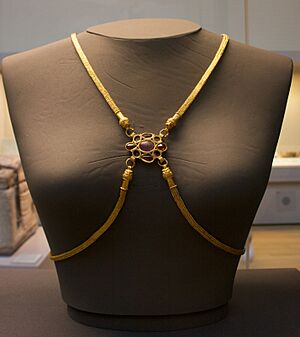Hoxne treasure facts for kids
The Hoxne Hoard is the largest collection of Roman gold and silver ever found in Britain. It also holds the most Roman gold and silver coins from the 300s and 400s AD found anywhere in the Roman Empire.
This amazing treasure was discovered by a metal detector user. It was found in the village of Hoxne in Suffolk, England. The discovery happened on 16 November 1992. The hoard includes 14,865 Roman gold, silver, and bronze coins. These coins are from the late 300s and early 400s AD. There are also about 200 items of silver tableware and gold jewellery.
Contents
Where to See the Treasure
Today, all the items from the Hoxne Hoard are kept at the British Museum in London. The most important pieces are always on display. You can also see a selection of the other objects there. In 1993, experts decided the hoard was worth £1.75 million. That's a lot of money!
How the Hoard Was Buried
The treasure was carefully buried in an oak box or a small chest. Inside, some items were placed in smaller wooden boxes. Others were wrapped in fabric or put into bags. When archaeologists dug up the site, they found parts of the chest. They also found pieces like hinges and locks.
The coins in the hoard help us know when it was buried. They show it was hidden after AD 407. This was around the time when Roman Britain was no longer a Roman province.
Who Owned the Treasure?
We don't know who owned the Hoxne Hoard or why they buried it. However, it was packed very neatly. The items look like things a very rich family would own. The hoard doesn't have large silver serving dishes or some common types of jewellery. This suggests that the hoard might only be part of the owner's total wealth.
Special Items in the Hoard
The Hoxne Hoard contains several rare and important objects. One special item is a gold body-chain. There are also silver pepper-pots that were partly covered in gold. When the hoard was found, archaeologists carefully dug it up. Most of the items were still in their original places and in good condition.
This discovery has also helped improve how metal detector users and archaeologists work together. It even led to changes in English law about finding treasure.
Related pages





